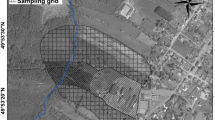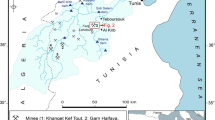Abstract
The study used 276 urban soils and 447 rural soils collected from in and around the UK town of Northampton and focussed on the fractionation of Pb. The Pb fractionation obtained from total element data was compared to the fractionation of Pb in a subset of 10 urban soils obtained using a sequential extraction method. The fractionation of the Pb from the total element data and from the sequential extractions was estimated using a self-modelling mixture resolution statistical model. The bioaccessibility of Pb in a subset of 50 of the urban soils, as measured using the unified BARGE method, was shown to be quantitatively linked with Pb fractionation from both the total element and the sequential extraction data. Three intrinsic soil components from the regional total element data model and one physico-chemical component from the sequential extraction data model were identified as the sources of bioaccessible Pb. The source of bioaccessible Pb in both rural and urban soils was tentatively identified as a fine-grained pyromorphite mineral.













Similar content being viewed by others
References
Abollino, O., Malandrino, M., Giacomino, A., & Mentasti, E. (2011). The role of chemometrics in single and sequential extraction assays: A review: Part I. Extraction procedures, uni- and bivariate techniques and multivariate variable reduction techniques for pattern recognition. Analytica Chimica Acta, 688(2), 104–121. doi:10.1016/j.aca.2010.12.020.
Akaike, H. (1974). A new look at the statistical model identification. IEEE Transactions on Automatic Control, 19(6), 716–723.
Allen, M. A., Cave, M. R., Chenery, S. R. N., Gowing, C. J. B., & Reeder, S. (2011). Sample preparation and inorganic analysis for urban geochemical survey soil and sediment samples. In C. C. Johnson, A. Demetriades, J. Locutura & R. T. Ottesen (Eds.), Mapping the chemical environment of urban areas (pp. 28–46). Wiley.
Ander, E. L., Johnson, C. C., Cave, M. R., Palumbo-Roe, B., Nathanail, C. P., & Lark, R. M. (2013). Methodology for the determination of normal background concentrations of contaminants in English soil. Science of the Total Environment, 454–455(0), 604–618, doi:http://dx.doi.org/10.1016/j.scitotenv.2013.03.005.
Bacon, J. R., & Davidson, C. M. (2008). Is there a future for sequential chemical extraction? Analyst, 133, 25–46.
Broadway, A., Cave, M. R., Wragg, J., Fordyce, F. M., Bewley, R. J. F., Graham, M. C., et al. (2010). Determination of the bioaccessibility of chromium in Glasgow soil and the implications for human health risk assessment. Science of the Total Environment, 409, 267–277. doi:10.1016/j.scitotenv.2010.09.007.
Caboche, J. (2009). Validation d’un test de mesure de bioaccessibilité. Application à quatre éléments traces métallique dans les sols: As,Cd, Pb et Sb. Nancy: L’Institut National Polytechnique de Lorraine.
Calabrese, E. J., Stanek, E. J., & Barnes, R. (1997). Soil ingestion rates in children identified by parental observation as likely high soil ingesters. Journal of Soil Contamination, 6(3), 271–279.
Cave, M. (2008). The use of self modelling mixture resolution methods for the interpretation of geochemical data sets British Geological Survey, IR/08/035.
Cave, M. R., Milodowski, A. E., & Friel, E. N. (2004). Evaluation of a method for identification of host physico-chemical phases for trace metals and measurement of their solid-phase partitioning in soil samples by nitric acid extraction and chemometric mixture resolution. Geochemistry: Exploration, Environment, Analysis, 4, 71–86.
Cave, M. R., & Wragg, J. (1997). Measurement of trace element distributions in soils and sediments using sequential leach data and a non-specific extraction system with chemometric data processing. Analyst, 122(11), 1211–1221.
Cave, M. R., Wragg, J., Denys, S., Jondreville, C., & Feidt, C. (2011). Oral bioavailability. In F. Swartjes (Ed.), Dealing with contaminated sites: From theory towards practical application. Berlin: Springer.
Cave, M. R., Wragg, J., & Harrison, H. (2013). Measurement modelling and mapping of arsenic bioaccessibility in Northampton, UK. Journal of Environmental Science and Health Part A, 48(6), 629–640.
Chen, C., Dynes, J. J., Wang, J., Karunakaran, C., & Sparks, D. L. (2014). Soft X-ray spectromicroscopy study of mineral-organic matter associations in pasture soil clay fractions. Environmental Science and Technology, 48(12), 6678–6686. doi:10.1021/es405485a.
Cornell, R. M., & Schwertmann, U. (1996). The iron oxides—Structure properties, reactions, occurrences and uses. Weinheim: VCH Publishers.
Cotter-Howells, J. D., Champness, P. E., Charnocky, J. M., & Pattrick, R. A. D. (1994). Identification of pyromorphite in mine-waste contaminated soils by ATEM and EXAFS. European Journal of Soil Science, 45(4), 393–402. doi:10.1111/j.1365-2389.1994.tb00524.x.
Debela, F., Arocena, J. M., Thring, R. W., & Whitcombe, T. (2010). Organic acid-induced release of lead from pyromorphite and its relevance to reclamation of Pb-contaminated soils. Chemosphere, 80(4), 450–456. doi:10.1016/j.chemosphere.2010.04.025.
Denys, S., Caboche, J., Tack, K., Rychen, G., Wragg, J., Cave, M., et al. (2012). In vivo validation of the unified BARGE method to assess the bioaccessibility of arsenic, antimony, cadmium, and lead in soils. Environmental Science and Technology, 46, 6252–6260. doi:10.1021/es3006942.
Duggan, M. J., Inskip, M. J., Rundle, S. A., & Moorcroft, J. S. (1985). Lead in playground dust and on the hands of schoolchildren. Science of the Total Environment, 44(1), 65–79.
Flight, D. M. A., & Scheib, A. J. (2011). Soil geochemical baselines in UK urban centres: The G-BASE project. In C. Johnson, A. Demetriades, J. Locutura, & R. T. Ottesen (Eds.), Mapping the chemical environment of urban areas (pp. 186–206). Oxford: Wiley-Blackwell.
Hettiarachchi, G. M., & Pierzynski, G. M. (2004). Soil lead bioavailability and in situ remediation of lead-contaminated soils: A review. Environmental Progress, 23(1), 78–93. doi:10.1002/ep.10004.
Johnson, C. C. (2011). Understanding the quality of chemical data from the urban environment—Part 1: Quality control procedures. In C. C. Johnson, A. Demetriades, J. Locutura, & R. T. Ottesen (Eds.), Mapping the chemical environment of urban areas (pp. 61–76). Oxford: Wiley-Blackwell.
Johnson, C. C., Breward, N., Ander, E. L., & Ault, L. (2005). G-BASE: Baseline geochemical mapping of Great Britain and Northern Ireland. Geochemistry: Exploration, Environment, Analysis, 5(4), 347–357.
Oomen, A. G., Hack, A., Minekus, M., Zeijdner, E., Cornelis, C., Schoeters, G., et al. (2002). Comparison of five in vitro digestion models to study the bioaccessibility of soil contaminants. Environmental Science and Technology, 36(15), 3326–3334.
Pelfrene, A., Waterlot, C., Mazzuca, M., Nisse, C., Bidar, G., & Francis, D. (2011). Assessing Cd, Pb, Zn human bioaccessibility in smelter-contaminated agricultural topsoils (northern France). Environmental Geochemistry and Health, 33, 477–493.
R Development Core Team. (2011). R: A language and environment for statistical computing. Vienna, Austria.: R Foundation for Statistical Computing.
Roussel, H., Waterlot, C., Pelfrene, A., Pruvot, C., Mazzuca, M., & Douay, F. (2010). Cd, Pb and Zn oral bioaccessibility of urban soils contaminated in the past by atmospheric emissions from two lead and zinc smelters. Archives of Environmental Contamination and Toxicology, 58(4), 945–954.
Scheckel, K. G., Ryan, J. A., Allen, D., & Lescano, N. V. (2005). Determining speciation of Pb in phosphate-amended soils: Method limitations. Science of the Total Environment, 350(1–3), 261–272. doi:http://dx.doi.org/10.1016/j.scitotenv.2005.01.020.
Tang, X. Y., Zhu, Y. G., Chen, S. B., Tang, L. L., & Chen, X. P. (2004). Assessment of the effectiveness of different phosphorus fertilizers to remediate Pb-contaminated soil using in vitro test. Environment International, 30(4), 531–537. doi:10.1016/j.envint.2003.10.008.
Watts, M. J., Button, M., Brewer, T. S. D., Jenkin, G. R. T., & Harrington, C. F. (2008). Quantitative arsenic speciation in two species of earthworms from a former mini site. Journal of Environmental Monitoring, 10, 753–759.
Wragg, J. (2009). BGS Guidance material 102, ironstone soil, certificate of analysis. British geological survey, IR/09/006.
Wragg, J., & Cave, M. R. (2012). Assessment of a geochemical extraction procedure to determine the solid phase fractionation and bioaccessibility of potentially harmful elements in soils: A case study using the NIST 2710 reference soil. Analytica Chimica Acta, 722, 43–54. doi:10.1016/j.aca.2012.02.008.
Wragg, J., Cave, M. R., Basta, N., Brandon, E., Casteel, S., Denys, S., et al. (2011). An inter-laboratory trial of the unified BARGE bioaccessibility method for arsenic, cadmium and lead in soil. Science of the Total Environment, 409, 4016–4030.
Wragg, J., Cave, M., & Nathanail, P. (2007). A study of the relationship between arsenic bioaccessibility and its solid-phase distribution in soils from Wellingborough, UK. Journal of Environmental Science and Health Part A, 42(9), 1303–1315.
Wragg, J., Cave, M., Taylor, H., Basta, N., Brandon, E., Casteel, S., et al. (2009). Interlaboratory trial of a unified bioaccessibility procedure. Open. Nottingham: British Geological Survey.
Xie, L., & Giammar, D. E. (2007). Equilibrium solubility and dissolution rate of the lead phosphate chloropyromorphite. Environmental Science and Technology, 41(23), 8050–8055. doi:10.1021/es071517e.
Acknowledgments
This work is published with permission of the Executive Director of the British Geological Survey.
Author information
Authors and Affiliations
Corresponding author
Rights and permissions
About this article
Cite this article
Cave, M., Wragg, J., Gowing, C. et al. Measuring the solid-phase fractionation of lead in urban and rural soils using a combination of geochemical survey data and chemical extractions. Environ Geochem Health 37, 779–790 (2015). https://doi.org/10.1007/s10653-015-9697-9
Received:
Accepted:
Published:
Issue Date:
DOI: https://doi.org/10.1007/s10653-015-9697-9




